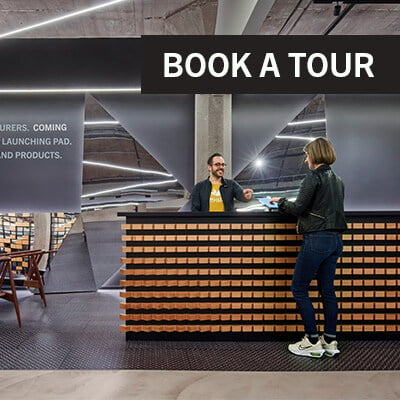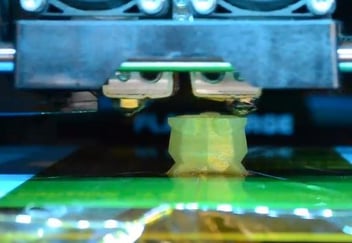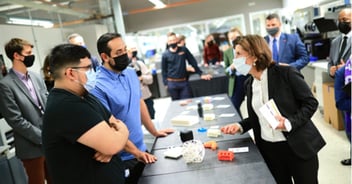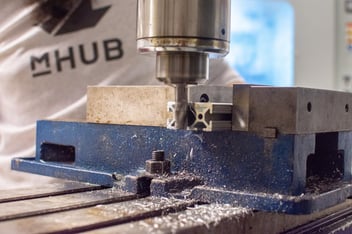In 2020, 60% of US manufacturers experienced disruptions to their operations.
The pandemic shed some light, and intensely, on the shaky foundation of the global supply chain and opportunities for the US to take back certain segments of manufacturing. While painful, these disruptions encouraged the industry to move faster, innovate harder, and show resilience in brand new ways. If there was ever a time to push the industry towards progress, the pandemic was the “rip the band-aid off” moment, and these are the foremost manufacturing trends that have resulted.
Manufacturing Trend #1: IoT
We have been charging full steam ahead into the fourth industrial revolution, largely dominated by the surge in IoT in industry. IoT in manufacturing has major implications for efficiency and the bottom line but also employee safety and satisfaction. But let’s look at a manufacturing trend that clearly impacts operational overhead: predictive maintenance. While standard procedure dictates and expects unplanned machinery/equipment failure, costing thousands even hundreds of thousands of dollars in lost production time and maintenance, smart machines equipped with sensors can communicate system updates and monitor machinery so businesses can plan accordingly by using predictive analysis to make informed decisions. While data is being continuously analyzed and processed, manufacturers will have the ability to not only predict when machines will break down, but also measure and manage machine performance and tighten quality control to prevent unexpected failures, all while keeping workers safe.
Manufacturing Trend #2: Augmented and Virtual Reality
As the COVID-19 pandemic continues to cause significant obstacles for the manufacturing industry, look towards augmented reality (AR) and virtual reality (VR) to gain attention as a manufacturing trend. For many, this has presented itself as an opportunity to explore these emerging technologies in an applicable context that was only recently seen as exploratory. On the technical side, utilizing AR/VR allows technicians the possibility to conduct remote assistance for anything from basic troubleshooting to in-depth evaluations and analysis. This allows staff previously tied to the manufacturing floor, for proximity to machines and equipment, the ability to work remotely.
Another exciting use of AR/VR in 2021 is its application in areas of wellness, mental health, and even surgical operations. Harnessed for their ability to deliver patients more convenient, streamlined care, more and more health practitioners are collaborating with manufacturers of all sizes to develop and apply AR/VR for the health-tech industry.
Manufacturing Trend #3: 3D Printing
3D printing, also commonly referred to as additive manufacturing, has seen a substantial up-tick in recent years. Many industries are adopting this technology to help improve various processes in which 3D printing has shown great success. This trend is becoming highly prevalent in the manufacturing industry where it is estimated that nearly two-thirds of manufacturers have already incorporated 3D printing into their business in some way.
Over the past couple of years, we have seen how 3D printing is outperforming tooling and prototyping which are timely and costly processes. Equipped with additive manufacturing, businesses have more control over prototyping, the precision of fabrication of products, and faster to-market time. Various industries within manufacturing have utilized 3D printing too including consumer goods like cosmetics, jewelry, footwear, industrial goods, as well as the aerospace and automotive industries. As the technology of 3D printing expands, there’s no doubt that we will see printing capabilities expand with various materials including glass, cement, ceramics, and improvements to metal which will give manufacturers more flexibility and creative ability to generate more complex prototypes and products.
Manufacturing Trend #4: Digital Twins and Investment
First off, just what is a ‘digital twin’? In layman’s terms, a digital twin is a computerized version of a physical product or environment. This means that the data from sensors in the real world can be implemented into the twin to develop simulations with hundreds of outcomes. So what does that mean for manufacturing. This concept allows manufacturers to run simulations with their upcoming products or new processes to help understand potential usage, reliability, and efficiency. Look no further than industry giants such as Boeing, Bosch, Cognizant, and many, many more.
The popularity of digital twin technology has grown exponentially over the past few years with its role in manufacturing and effect on supply chain expansion and logistics. The opportunity for an organization to digitally replicate and analyze their manufacturing footprint is immeasurably valuable. As Matt Tichon–VP of Industry Strategy at LLamasoft—says:
“If there was a shortage of raw material, businesses could determine the best options for a secondary source of supply while taking into account the implications of costs, service, and capacity…Taking this approach allows organizations to minimize the impact of the disruption while simultaneously understanding the margins and customer full rates…In a world where disruptions are becoming part and parcel of everyday life, implement digital twin technology is not just smart, but essential.”
Manufacturing industry leaders are increasingly recognizing the integral role that this “trend”—let’s call it,—is and will play in the field’s future.
Manufacturing Trend #5: Robotics
Asimov be damned, the robots are here for good. The question is: how do we as manufacturers best utilize this technology? In 2021, we see an implementation of robotics technology in areas of supply chain logistics, smart factories, artificial intelligence and even energy.
The COVID-19 pandemic has illuminated the weakness of globalized supply chains. This privileges manufacturers to rethink supply with a completely new model; one that is shaped by robotics. When productivity is actualized through automation, there is a rise in productivity and flexibility that may not have previously been accessible before. Furthermore, investments in modern robot technology are also driven by the global pursuit of decreased carbon footprints.
Manufacturing sectors that have previously overlooked robotics, including but not limited to, food and beverage, textiles, and plastics, are turning towards automation in efforts to create new business models now that producers can diversify much more easily. As industry leaders have shown us, the future belongs to the ‘bots, especially in contexts like the “smart factory.” Successful manufacturers are synthesizing the old tech with the new and optimizing autonomous mobile robots (AMRs) to drive innovation, rather than dismantle old systems. This is all made possible by the trending software development that plays partner to our robot friends. As artificial intelligence begins combining with sensing systems, robots can master increasingly difficult and burdensome tasks. The value to manufacturing here is unquantifiable.
Ultimately, the aforementioned areas are certainly disrupting the established ways of manufacturing and we predict their influence and usage to only increase. With the advancement of digital technologies, these manufacturing trends are successfully pushing the limitations set forth by traditional manufacturing methodologies and practices and are simultaneously improving the way businesses operate. Providing the ability to maximize efficiency, cut down on costs and production time, and create safer and more responsive environments in varying capacities: these are all incredible outcomes being created by just a handful of key technologies.
mHUB is helping manufacturers integrate disruptive innovation into their business models and product development. For guidance on where to get started or to address a specific project or problem, contact mHUB’s Hardtech Development services team by completing the form below.





